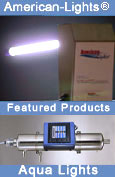

|
|
|
|
|
|
|
|
|
|
|
|

|
|
|
|
|
| Web Design by |
|
|
Facilities Standards For The Public Buildings
U. S. General Services Administration Office of the Chief Architect
Visit the GSA website at http://www.gsa.gov
Or read the article specifying the HVAC standards and UV light requirements below:5.9 HVAC Systems And Components
HVAC System Components
Air-Handling Units (AHU’s). Air-handling units shall be sized to not exceed 11,800 l/s (25,000 cfm). Smaller units are encouraged to facilitate flexible zone control, particularly for spaces that involve off-hour or high-load operating conditions. To the extent possible, “plug-n-play” AHU configurations should be considered, facilitating easy future adaptations to space-load changes. Psychrometric analyses (complete with chart diagrams) shall be prepared for each air-handling unit application, characterizing full and part load operating conditions. Air-handling unit/coil designs shall assure that conditioned space temperatures and humidity levels are within an acceptable range, per programmed requirements, and ASHRAE Standards 55 and 62.
Depending on sensible heat ratio characteristics, effective moisture control may require cooling coil air discharge dew point temperatures as low as 10°C (50°F). As required, provide face-by-pass or heat recovery features to re-heat cooling coil discharge temperatures for acceptable space entry. Provide a direct form of re-heat and/or humidification only if space conditions require tight environmental control, or if recurring day-long periods of unacceptable humidity levels would otherwise result.
Supply, Return and Relief Air Fans: Centrifugal doublewidth double-inlet forward curved and airfoil fans are preferable for VAV systems. All fans shall bear the AMCA seal and performance shall be based on tests made in accordance with AMCA Standard 210. Fans should be selected on the basis of required horsepower as well as sound power level ratings at full load and at part load conditions. Fan motors shall be sized so they do not run at overload anywhere on their operating curve. Fan operating characteristics must be checked for the entire range of flow conditions, particularly for forward curved
fans. Fan drives shall be selected for a 1.5 service factor and fan shafts should be selected to operate below the first critical speed. Thrust arresters should be designed for horizontal discharge fans operating at high static pressure.Coils: Individual finned tube coils should generally be between six and eight rows with at least 2.1 mm between fins (12 fins per inch) to ensure that the coils can be effectively and efficiently cleaned. Dehumidifying coils shall be selected for no more than negligible water droplet carryover beyond the drain pan at design conditions. All hot water heating and chilled water cooling coils shall be copper tube and copper finned materials. Equipment and other obstructions in the air stream shall be located sufficiently downstream of the coil so that it will not come in contact with the water droplet carryover. Cooling coils shall be selected at or below 2.5 m/s face velocity (500 fpm) to minimize moisture carryover. Heating coils shall be selected at or below 3.8 m/s face velocity (750 fpm).
Drains and Drain Pans: Drain pans shall be made of stainless steel, insulated and adequately sloped and trapped to assure drainage. Drains in draw-through configurations shall have traps with a depth and height differential between inlet and outlet equal to the design static pressure plus 2.54 mm (1 inch) minimum. Filter Sections: Air filtration shall be provided in every airhandling
system. Air-handling units shall have a disposable pre-filter and a final filter. The filter media shall be rated in accordance with ASHRAE Standard 52. Pre-filters shall be 30 percent to 35 percent efficient. Final filters shall be filters with 85 percent efficiency capable of filtering down to 3.0 microns per ASHRAE 52. Filter racks shall be designed to minimize the bypass of air around the filter media with a maximum bypass leakage of 0.5 percent.Filters shall be sized at 2.5 m/s (500 FPM) maximum face velocity. Filter media shall be fabricated so that fibrous shedding does not exceed levels prescribed by ASHRAE 52. The filter housing and all air- andling components downstream shall not be internally lined with fibrous insulation. Double-wall construction or an externally insulated sheet metal housing is acceptable. The filter change-out pressure drop, not the initial clean filter rating, must be used in determining fan pressure requirements. Differential pressure gauges and sensors shall be placed across each filter bank to allow quick and accurate assessment of filter dust loading as reflected by air-pressure loss through the filter and sensors shall be connected to building automation system.
Ultraviolet light (C band) emitters/lamps shall be incorporated downstream of all cooling coils and above all drain pans to control airborne and surface microbial growth and transfer. Applied fixtures/
lamps must be specifically manufactured for this purpose. Safety interlocks/features shall be provided to limit hazard to operating staff.Access Doors: Access Doors shall be provided at air handling units downstream of each coil, upstream of each filter section and adjacent to each drain pan and fan section. Access doors shall be of sufficient size to allow personnel to enter the unit to inspect and service all portions of the equipment components.
Plenum Boxes: Air-handling units shall be provided with plenum boxes where relief air is discharged from the airhandling unit. Plenum boxes may also be used on the return side of the unit in lieu of a mixing box. Air-flow control dampers shall be mounted on the ductwork connecting to the plenum box.
Mixing Boxes: Air-handling units shall be provided with mixing boxes where relief air is discharged from the airhandling unit. Mixing boxes may also be used on the return side of the unit in lieu of a plenum box. Air flow control dampers shall be mounted within the mixing box or on the ductwork connecting to the mixing box.
|HOME| |INDOOR AIR| |CONTACT| |SCIENCE FACTS| |PRESS RELEASES| |PRODUCTS| |FAQ| |BUSINESS PROGRAMS|

Copyright 1999-2006 Enhance-It, LLC